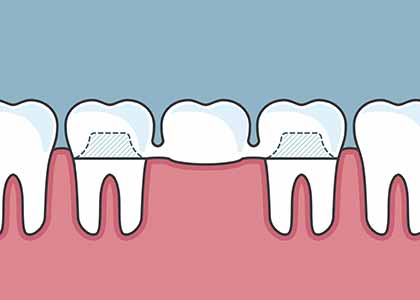What to expect before, during, and after dental bridge treatment in Indianapolis
Losing a permanent tooth can have a detrimental effect on your smile and your self-confidence. Natural teeth can be lost due to injury or disease. When a permanent tooth is lost or needs to be removed, options for replacement will be discussed right away so that the smile is not further affected by shifting teeth or hidden bacteria. Some of the options available for tooth replacement include partial dentures, dental bridges, and dental implants. For the permanent restoration of form and function, dental bridges are the most common choice.

Dr. Church and the team at Washington Street Dentistry provide gentle, compassionate dental bridge treatment to patients from Indianapolis and surrounding areas. These restorations are fixed, or anchored on the teeth adjacent to the gap using dental crowns. Made in a dental lab, the bridge will contain two crowns and an artificial tooth fused together for structural support. Once the crowns are bonded to teeth, the artificial tooth is secured in the gap, sitting on top of the gums. A fixed bridge is more stable than partial dentures, which are removable, and a bridge is a more affordable choice compared to dental implants. It is important to note, however, that implants can last a lifetime, whereas a bridge may need to be replaced after 10 to 15 years.
Before dental bridge treatment

During a consultation for tooth replacement, Dr. Church discusses the various options available, including details of each. If patients do not wish to invest in implants, or they have insufficient bone structure to support this form of treatment, plans will be made to create a customized dental bridge. After teeth are prepared for their custom-fitted crowns, impressions are made and temporaries applied.
During treatment
Fabrication of a dental bridge takes about two weeks. During the placement visit, temporary crowns will be removed and the permanent crowns are bonded to teeth carefully, and assessed for precise fit. We also check bite to ensure long lasting function and comfort.
After you receive your dental bridge

Patients are shown how to care for their dental bridge after treatment has been completed. Because the artificial tooth sits on top of the gums, flossing habits will change. Regular, proper flossing under the artificial tooth is a very important step towards controlling oral health. Failing to clean this area means that bacteria can collect beneath the bridge, weakening gum tissue and the bridge itself.
Tooth replacement does not have to be a stressful transition. Our staff is highly experienced, and committed to providing gentle care. Contact Washington Street Dentistry for your dental needs.
Share this Article
Back to Crowns and Bridges Page





